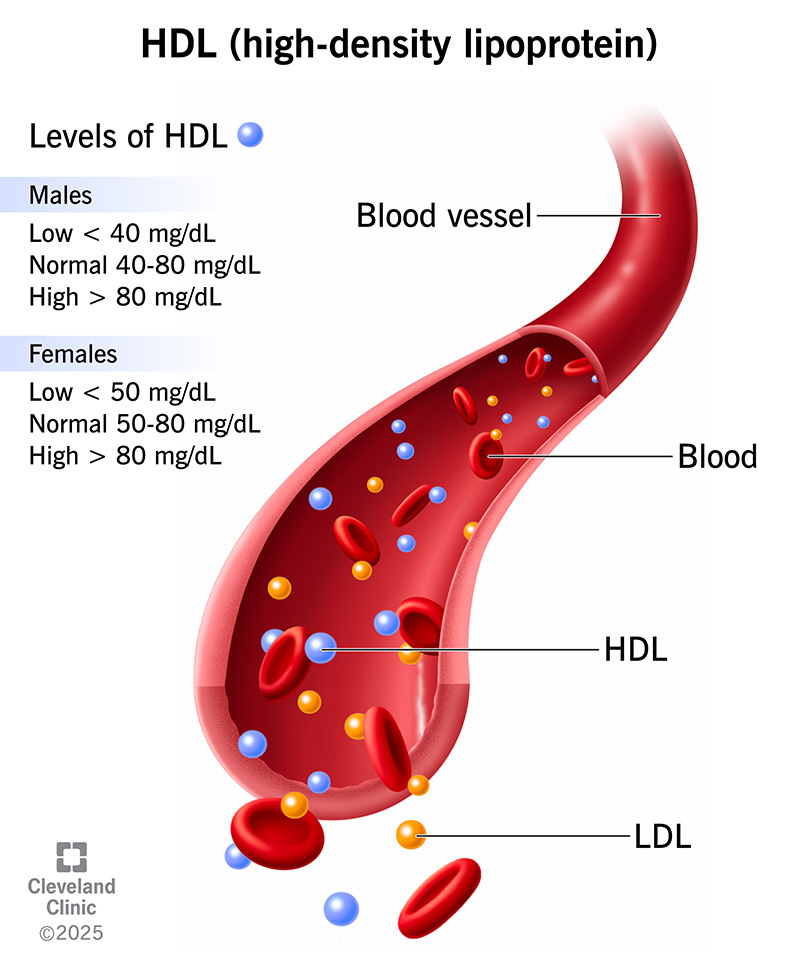HDL cholesterol is the “good” cholesterol because a healthy level lowers your risk of heart disease. The normal range is 40 to 80 mg/dL in males and 50 to 80 mg/dL in females. Your provider can check your levels with a simple blood test. HDL stands for high-density lipoprotein. It’s the name of the particle that carries cholesterol in your blood.
Advertisement
Cleveland Clinic is a non-profit academic medical center. Advertising on our site helps support our mission. We do not endorse non-Cleveland Clinic products or services. Policy

HDL cholesterol is a substance in your blood that helps your healthcare provider understand your risk for cardiovascular disease. It’s a type of lipid. You’ll see HDL cholesterol (also called HDL-C) on your lipid panel results along with things like LDL cholesterol, VLDL cholesterol and triglycerides.
Advertisement
Cleveland Clinic is a non-profit academic medical center. Advertising on our site helps support our mission. We do not endorse non-Cleveland Clinic products or services. Policy
In general, an HDL cholesterol level on the higher end of normal suggests your risk for heart disease is lower. This makes HDL cholesterol different from LDL cholesterol, which you should keep low.
But you don’t want your HDL cholesterol to be too high. Abnormally high levels may suggest that there’s an underlying dyslipidemia (abnormal balance between good and bad cholesterol). Your provider will help you keep your HDL cholesterol in the normal range to support your heart and overall health.
HDL stands for high-density lipoprotein. A lipoprotein is a particle made of lipids and proteins.
Lipoproteins circulate in your blood. They’re a bit like buses. Their main job is to transport cholesterol throughout your body to cells that need them. Cholesterol needs a ride because its chemical structure keeps it from traveling solo through your blood.
HDL is just one type of “bus” that travels in your blood. LDL and VLDL are other types. Your lipid panel shows the amount of cholesterol traveling on each type of bus at the moment your blood is drawn.
That means HDL cholesterol and HDL aren’t really the same thing. HDL refers to the particle or “bus,” and HDL cholesterol refers to some of the passengers on that bus. But most people use both terms to refer to the cholesterol level in your blood.
Advertisement
HDL particles are “good” because experts have linked levels on the higher end of normal with a lower risk of heart disease. HDL particles pick up extra cholesterol in your blood and deliver it to your liver. Your liver then breaks down this cholesterol and sends it out of your body through your poop. That’s a good thing because too much cholesterol in your blood raises your risk of plaque buildup in your artery walls.
You need enough HDL particles in your blood to pick up excess cholesterol and carry it to your liver. HDLs are also helpful because they combat inflammation and play a role in preventing blood clots.
Here are the normal and abnormal HDL cholesterol ranges for adults, which vary by sex:
For kids and teens, a normal HDL level is 45 to 80 mg/dL.
There are many reasons why your HDL cholesterol may be low, including:
Your HDL cholesterol level may be above 80 mg/dL due to:
Yes. If your HDL cholesterol is too low, your provider may suggest ways to raise it. These include eating heart-healthy foods, adding more physical activity to your routine and maintaining a weight that’s healthy for you.
If your HDL cholesterol is too high, your provider will look into the cause and tell you if you need treatment.
Making sense of your cholesterol test results can be confusing. There are many terms to learn, and some look very similar to each other. When you see HDL, think of “h” for “helpful.” HDLs help your body get rid of extra cholesterol. This supports the health of your heart and blood vessels.
If your HDL cholesterol is outside the normal range, your provider will find the cause. They’ll treat that cause and may also prescribe medicines to help support healthy cholesterol levels in your body. Remember that your provider is your partner in managing your cholesterol. They’ll help answer any questions you have.
Advertisement
Cleveland Clinic’s primary care providers offer lifelong medical care. From sinus infections and high blood pressure to preventive screening, we’re here for you.

Last reviewed on 06/02/2025.
Learn more about the Health Library and our editorial process.